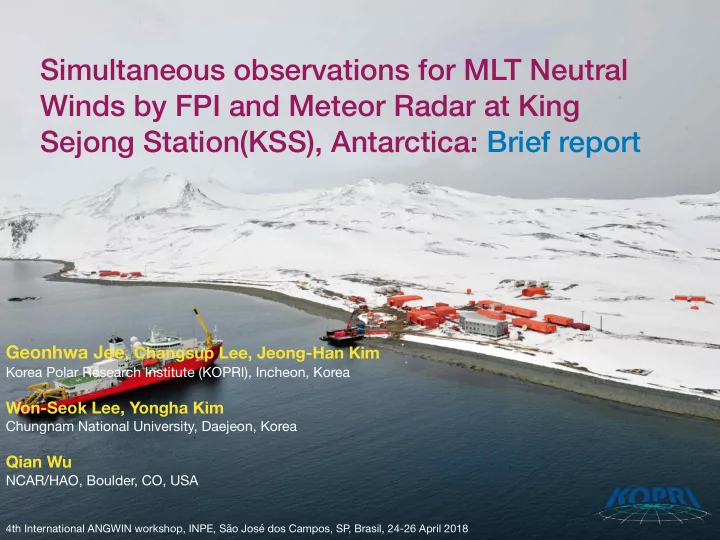

Simultaneous observations for MLT Neutral Winds by FPI and Meteor Radar at King Sejong Station(KSS), Antarctica: Brief report Geonhwa Jee , Changsup Lee, Jeong-Han Kim Korea Polar Research Institute (KOPRI), Incheon, Korea Won-Seok Lee, Yongha Kim Chungnam National University, Daejeon, Korea Qian Wu NCAR/HAO, Boulder, CO, USA 4th International ANGWIN workshop, INPE, São José dos Campos, SP , Brasil, 24-26 April 2018
King Sejong Station (KSS) King Sejong Station (KSS) 62° 13' S, 58° 47' W Palmer Geomagnetic North Pole Geomagnetic South Pole Dasan Station (& KHO) 78° 55' N, 11° 56' E Jang Bogo Station (JBS) Kiruna (Esrange) 74º 37' S, 164º 13' E 67° 51' N, 20° 13' E
King Sejong Station (KSS) Optical Obs. Meteor FPI & ASC Radar
Kiruna KSS-Meteor Radar Jang Bogo Station (JBS)
Kiruna KSS-Meteor Radar • ATRAD meteor detection radar Jang Bogo Station (JBS) • Continuously operated since March 2007 • Number of echo: 15,000~40,000 per day, which is more than twice of typical meteor radar observations • Hourly mean neutral wind profiles (75~105 km) and daily mean temperature at around the meteor peak height (~ 90 km)
KSS-FPI
KSS-FPI • It was operated by NCAR/HAO at US Palmer station, Antarctica • Moved to KSS in Jan. 2017 in collaboration with NCAR/ HAO • Operates with three filters for 630.0 nm, 557.7 nm, 892.0 nm airglow emissions • Snapshot winds for each filter with about 55 min. temporal resolution
Spatial Coverage 105 km 97 km 557.7nm meteor obs. 87 km 892.0nm 75 km ~200 km 250 km
FPI vs. MR FPI winds MR winds 55 min. (with 3 filters) 1 hour Temporal resol. : snap shot winds & temp. : hourly mean winds for each filter & daily mean temp. Spatial resol. ~200 km ~250 km 87 km (OH 892.0 nm) 75~105 km Height 97 km (O 557.7 nm) (with 2 km step) 250 km (O 630.0 nm)
FPI & MR : Meridional winds
FPI & MR : Zonal winds
N W E S → : OI 5577(97 km) → : OH 8920(87 km) → : meteor radar(75 ~ 105km, 2km bin)
N W E S → : OI 5577(97 km) → : OH 8920(87 km) → : meteor radar(75 ~ 105km, 2km bin)
N W E S → : OI 5577(97 km) → : OH 8920(87 km) → : meteor radar(75 ~ 105km, 2km bin)
N W E S → : OI 5577(97 km) → : OH 8920(87 km) → : meteor radar(75 ~ 105km, 2km bin)
Correlation btw MR and FPI winds
FPI vs. MR winds at mid- latitude region Yu et al ., 2016
Summary • Simultaneous measurements of MLT neutral winds at KSS, Antarctica. However, • Optical vs. radar • Snapshot vs. hourly mean winds • Relatively large di ff erences may indicate that there are large variabilities within 1-hour time period in the MLT winds. • Any complementary aspects of these two measurements? • What information can we obtain with this simultaneous observation? • With the MR wind observations, is it necessary to keep observing the MLT winds by FPI?
Future works • Large number of observed meteor echos: 15,000~40,000 per day • Increase the temporal resolution of neutral wind observation: 1-hour —> 0.5-hour • Daily mean temperature —> separate day & night mean temperatures • Compare them with FPI winds & temp.
Recommend
More recommend